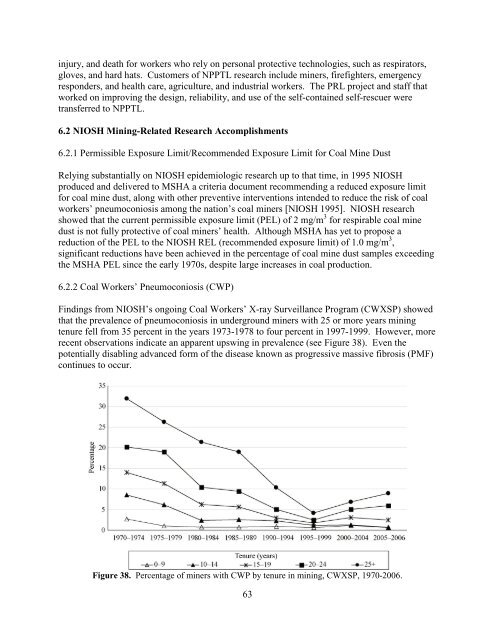One Hundred Years of Federal Mining Safety and Health Research
One Hundred Years of Federal Mining Safety and Health Research
One Hundred Years of Federal Mining Safety and Health Research
- No tags were found...
Create successful ePaper yourself
Turn your PDF publications into a flip-book with our unique Google optimized e-Paper software.
injury, <strong>and</strong> death for workers who rely on personal protective technologies, such as respirators,<br />
gloves, <strong>and</strong> hard hats. Customers <strong>of</strong> NPPTL research include miners, firefighters, emergency<br />
responders, <strong>and</strong> health care, agriculture, <strong>and</strong> industrial workers. The PRL project <strong>and</strong> staff that<br />
worked on improving the design, reliability, <strong>and</strong> use <strong>of</strong> the self-contained self-rescuer were<br />
transferred to NPPTL.<br />
6.2 NIOSH <strong>Mining</strong>-Related <strong>Research</strong> Accomplishments<br />
6.2.1 Permissible Exposure Limit/Recommended Exposure Limit for Coal Mine Dust<br />
Relying substantially on NIOSH epidemiologic research up to that time, in 1995 NIOSH<br />
produced <strong>and</strong> delivered to MSHA a criteria document recommending a reduced exposure limit<br />
for coal mine dust, along with other preventive interventions intended to reduce the risk <strong>of</strong> coal<br />
workers’ pneumoconiosis among the nation’s coal miners [NIOSH 1995]. NIOSH research<br />
showed that the current permissible exposure limit (PEL) <strong>of</strong> 2 mg/m 3 for respirable coal mine<br />
dust is not fully protective <strong>of</strong> coal miners’ health. Although MSHA has yet to propose a<br />
reduction <strong>of</strong> the PEL to the NIOSH REL (recommended exposure limit) <strong>of</strong> 1.0 mg/m 3 ,<br />
significant reductions have been achieved in the percentage <strong>of</strong> coal mine dust samples exceeding<br />
the MSHA PEL since the early 1970s, despite large increases in coal production.<br />
6.2.2 Coal Workers’ Pneumoconiosis (CWP)<br />
Findings from NIOSH’s ongoing Coal Workers’ X-ray Surveillance Program (CWXSP) showed<br />
that the prevalence <strong>of</strong> pneumoconiosis in underground miners with 25 or more years mining<br />
tenure fell from 35 percent in the years 1973-1978 to four percent in 1997-1999. However, more<br />
recent observations indicate an apparent upswing in prevalence (see Figure 38). Even the<br />
potentially disabling advanced form <strong>of</strong> the disease known as progressive massive fibrosis (PMF)<br />
continues to occur.<br />
Figure 38. Percentage <strong>of</strong> miners with CWP by tenure in mining, CWXSP, 1970-2006.<br />
63
















